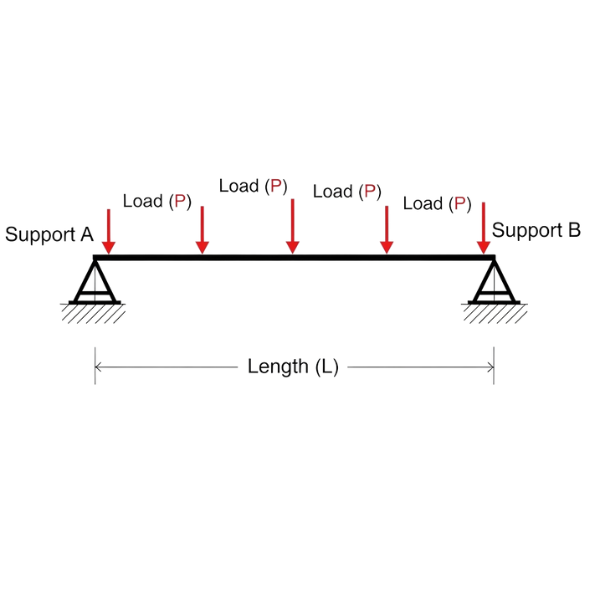Phone:
(701)814-6992
Physical address:
6296 Donnelly Plaza
Ratkeville, Bahamas.
Analyze beam shear force, bending moment, and deflection under various loads.
0 kN
0 kN·m
0 mm
Your feedback helps us build better tools.
Beam Load Analysis is a fundamental concept in structural engineering used to determine the internal forces acting on a beam when subjected to external loads. This analysis is crucial for designing safe and efficient structures.
The primary results of this analysis are the Shear Force Diagram (SFD), which shows the variation of shear force along the beam's length, and the Bending Moment Diagram (BMD), which illustrates the variation of bending moment. These diagrams help engineers identify the points of maximum stress and deflection to ensure the beam's design is robust.
Follow these steps for a basic structural analysis of a beam.
Identify length, material (Elastic Modulus), cross-section (Moment of Inertia), and support type.
Specify the type (e.g., UDL, Point Load), magnitude, and location of all forces acting on the beam.
Use static equilibrium equations to find support reactions, then calculate shear and moment values.
Here are some standard formulas used to calculate maximum shear, moment, and deflection for basic beam configurations. (P = Point Load, w = Uniform Load, L = Length)


Understanding the forces within a beam is critical for structural safety and efficiency. Proper analysis prevents material failure, optimizes material usage, and ensures the long-term stability of structures like bridges, buildings, and aircraft wings. This calculator provides the instant insights needed to make informed design decisions.
Analyze Your BeamA Simply Supported beam is supported at both ends, with one end on a hinge/pin and the other on a roller, allowing rotation but not vertical movement. A Cantilever beam is fixed at one end and free at the other, like a balcony or diving board.
A Point Load acts on a single, specific point on the beam. A Uniformly Distributed Load (UDL) is spread evenly across a section or the entire length of the beam, like the weight of the beam itself or snow on a roof.
These two properties determine the beam's stiffness. The Elastic Modulus (E) is a material property measuring its resistance to elastic deformation. The Moment of Inertia (I) is a geometric property of the beam's cross-section that measures its resistance to bending. Together, the product EI is known as the flexural rigidity.
The calculator uses standard SI units. Length is in meters (m), Load is in kilonewtons (kN) or kilonewtons per meter (kN/m), Elastic Modulus is in gigapascals (GPa), and Moment of Inertia is in m⁴ (multiplied by 10⁻⁶ for convenience). Results are given in kN, kN·m, and millimeters (mm).
This tool is designed for basic, determinate beam configurations. It does not support multiple loads, combined load types (e.g., a point load and a UDL simultaneously), or indeterminate structures like continuous beams or propped cantilevers. For those scenarios, more advanced structural analysis software is required.
Deflection is calculated using standard beam deflection formulas, which are derived from the Euler-Bernoulli beam theory. The calculation depends on the beam's length (L), the load (w or P), the material's Elastic Modulus (E), and the cross-section's Moment of Inertia (I). The specific formula changes based on the support and load type.
See why our calculator is a go-to tool for structural analysis.
Alistair Finch
Structural Engineer
"An indispensable tool for quick sanity checks on my designs. The diagrams are clean and accurate."
Bronwyn Rhys
Architecture Student
"This helped me visualize the concepts from my structures class so much better. A lifesaver for homework."
Cassian Valerius
DIY Enthusiast
"Used this to double check the beam size for a small deck project. It's simple and gives me peace of mind."
Elara Vance
Civil Engineering Tech
"Saves me a ton of time on preliminary calculations before running a full finite element analysis."
Peregrine Thorne
Mechanical Engineer
"The interface is intuitive. It correctly handles the sign conventions for shear and moment, which many online tools get wrong."
Isolde Beaumont
Professor of Engineering
"I recommend this to all my undergraduate students. It's an excellent, interactive way to understand the fundamentals."
Theron Petrov
Construction Manager
"Great for on-the-fly checks on site. Faster than pulling out my old textbooks."
Seraphina Dubois
Aerospace Engineer
"While simplified, it's a very solid tool for first-pass analysis on components. Well done."
Leander Croft
Fabricator
"It works, but it would be great to see options for I-beams or other standard shapes instead of just inputting the inertia."
We'd love to hear from you! If you have suggestions, questions, or just want to say hello, please get in touch.